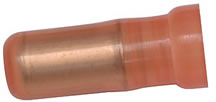 Wire caps offer a simple and effective way to connect wires. Regardless of the type, you can connect most small wires by using wire caps. They consist of cap-like parts with a conductive inner body. Upon placing the ends of two wires into the body of a wire cap, you can then crimp it. Crimping the wire cap will force the conductive inner body to collapse over the end of the wires.
Wire caps offer a simple and effective way to connect wires. Regardless of the type, you can connect most small wires by using wire caps. They consist of cap-like parts with a conductive inner body. Upon placing the ends of two wires into the body of a wire cap, you can then crimp it. Crimping the wire cap will force the conductive inner body to collapse over the end of the wires.
Overview of Wire Caps
Also known as crimp-on wire connectors, wire caps are connectors that are used to join two or more wires with a crimping tool. They like up to their namesake by featuring a cap-like design.
Wire caps are cylindrical connectors with a hollow body. The exterior of the body is typically made of a soft and elastic material, such as silicone rubber. The interior of the body, on the other hand, is wrapped in a conductive material, such as aluminum or copper.
How Wire Caps Work
Wire caps ensure electrical conductivity between the two wires with which they are used. You’ll have to remove the shielding of the ends of the wires beforehand. Once the shielding has been removed, you can insert the exposed ends of the wires into a wire cap.
Next, you’ll need to use a crimping tool. Crimping a wire cap will permanently join the wires by collapsing the cap’s inner body. All wire caps require crimping. You can place a wire cap in the center of a crimping tool’s teeth, and when engaged, the crimping tool will collapse its inner body.
Wire Caps vs Twist-On Connectors
In addition to wire caps, there are twist-on connectors. Twist-on connectors are used for the same purpose as their wire cap counterparts. To connect two wires together, you can use either a wire cap or a twist-on connector.
Twist-on connectors are distinguished from wire caps by their method of connection. They still have a hollow inner body, which is made of a conductive material — just like wire caps. Twist-on connectors, however, don’t require a crimping tool.
To use twist-on connectors, you just need to twist them after inserting the wires into them. Twisting a twist-on connector will force the ends of the wires to wrap around themselves. While they are convenient, though, twist-on connectors don’t offer the same level of security as wire caps. Vibrations may cause the wires to loosen if they are connected with a twist-on connector.



